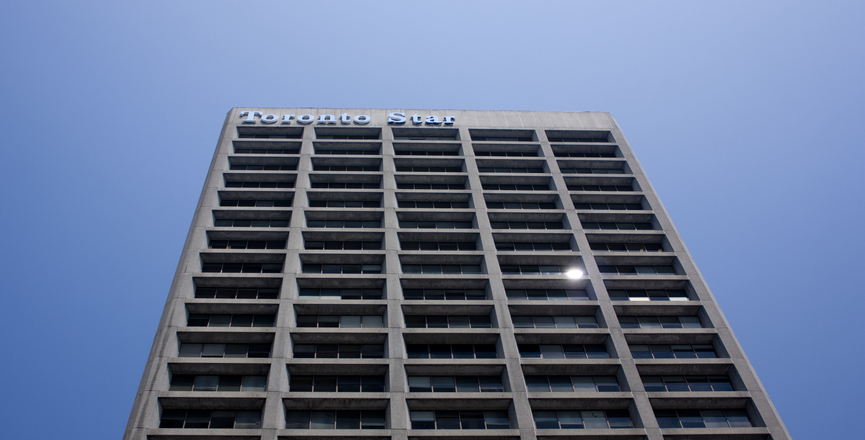Bruce Arthur, the Toronto Star‘s marquee sports columnist, signed it. So did veteran, award-winning reporters Peter Edwards, Jennifer Yang, Jesse McLean, Katie Daubs and Wendy Gillis. Scott Colby signed in his position of editor of the Star’s opinion pages. And so did what looks like a multi-cultural majority of the paper’s younger journalists.
They included team editors, digital producers, librarians, photographers and radio room interns. More than five dozen of them, representing a good portion of the newsroom.
The letter they signed and quickly made public was unprecedented and had one purpose: A public shaming of the paper’s most prominent columnist, Rosie DiManno.
They called her out for what they called a “hateful, racist” email she sent to all editorial employees in response to her paper’s appointment of fellow columnist Shree Paradkar to a new role as “internal ombud,” with a focus on discrimination and race.
Rosie’s provocative email about that appointment said: “This is a fucking abomination and I will not submit to yet another level of interference in an insanely over-micro-managed newsroom.”
You can read the text of the letter, signed by 62 Star newsroom colleagues and addressed to the paper’s senior management, here. They demanded that the publisher and editor condemn DiManno’s comments, make her apologize to the newsroom, take anti-racism training and “demonstrate an understanding of why these measures are necessary.”
Good luck on all of that, I say.
Anyone who knows DiManno knows she will never submit to any of these demands. Hell, she scarcely allows anyone to touch a word of her long and adjective-heavy columns. The newsroom’s senior managers have a long record of letting her transgressions go unpunished.
So what her newsroom colleagues so audaciously are asking for is probably beyond the ability of publisher John Boynton or editor-in-chief Irene Gentle to deliver on. They’re probably going to have to choose: Lose your biggest journalistic star or lose the newsroom. Readers will have to wait to see how they handle it, but in the two days since the shit hit the fan over her remarks, DiManno’s column has not appeared.
What this public shaming is all about is something even more difficult for the paper to resolve.
The staff letter named it. DiManno’s email, it said, “is an unacceptable denigration of the concerns and experiences of BIPOC newsroom members; it is in effect an example of the kind of racism, institutionalized or otherwise, that prompted the need for Paradkar’s position.”
It’s not up to me to judge if DiManno is a racist. But she is definitely part of what the letter calls the “invisible hierarchies” of the paper — populated by those who are older, whiter, more privileged, the beneficiaries of a macho, star-centric culture that has existed there for decades.
Calls for more diversity to cover a richly multicultural city have ushered in a younger, more diverse new breed of journalists who are questioning the status quo at the Star. They have not yet managed to penetrate the ranks of managers who actually determine what stories get covered and how people are treated and so they are frustrated when the winds of change — personified by the Black Lives Matter movement — demand that institutions dismantle systemic racism.
The latest revolt, and the spectacle of most of a newsroom pillorying a colleague in public, is a sure sign that the Star has serious issues to tackle in its newsroom culture. It is also a reflection that management has for too long failed to rein in DiManno. According to the letter, she has been “degrading and aggressive to members of multiple departments and has never faced repercussions that we have seen.”
Perhaps this is welcome change. Years ago, a similar plurality of the Star newsroom signed what was called The Hack Manifesto. It was a reaction to over-editing and a top-down hierarchical management. It resulted in a series of soul-searching staff meetings and a rule — still in effect — that editors must consult writers before they make any substantial changes to their stories.
Perhaps this will open a dialogue that will make Shree Paradkar’s new assignment less challenging than it appears to be right now. But perhaps it is asking too much of a terribly divided newsroom — it’s notable that no senior editors signed the anti-DiManno letter. Either they refused to sign on, or they were never approached to do so.
My guess, based on the players involved, is that someone’s head is soon about to roll.
From media executive to media critic, John Miller has seen journalism from all sides (and he often doesn’t like what he sees). He draws on his 40 years in news, including five years as deputy managing editor of the Toronto Star, and 10 years as chairman of the School of Journalism at Ryerson University. His 1998 book Yesterday’s News documented how newspapers were forfeiting their role as our primary information source.
Image: petmutt/Flickr




